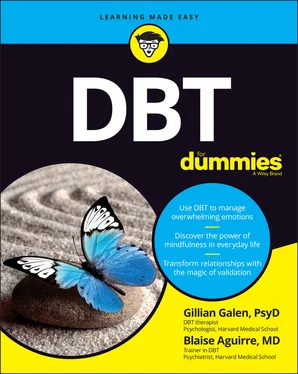Opposite action works best when your emotions do not fit the facts of a current situation. If you’re afraid of a rattlesnake in your living room in Arizona, then the fear fits the facts and it’s justified if the snake is there. If the snake isn’t there, then the fear doesn’t fit the facts and is unjustified. If the emotion doesn’t fit the facts, this means that its intensity and duration aren’t effective in helping you achieve your long-term goals.
If you’re going to use opposite action, it’s important to throw yourself fully into the skill. Engage in behaviors that are opposite or different to the ones that you feel the urge to do, and then use opposite emotion words, thoughts, facial expressions, tone of voice, and body posture. For instance, consider these examples:
Fear: If you feel afraid, approach the situation or trigger that gives you anxiety. Try to face your fear. Engage in behaviors that increase your sense of control over your fear. You can repeatedly expose yourself to your unjustified fear in order to desensitize yourself. For instance, if you’re afraid of speaking to your boss, then you can repeatedly practice approaching her with confidence.
Anger: If you are angry at someone and feel like lashing out, you can instead initially avoid them rather than attack them, and then practice empathy for them and the behavior that made them do what they did. You can try to find the kernel of truth in their actions. Something caused their actions. Be curious about what it was.
Sadness: If you’re feeling low or depressed, rather than avoiding, isolating, or staying in bed, you can approach, engage, and get out of bed. You don’t isolate, but instead engage in activities that connect and keep you active and busy.
Shame: If you feel shame over something you have done and the shame is justified, then apologize. If the shame doesn’t fit the facts and is unjustified, then you need to engage fully in the situation that induced the shame by participating in social interactions, and even share your ideas and behaviors that led to the experience of shame.
Guilt: Similar to shame, if your guilt fits the facts, you need to apologize for the transgression. If your guilt is unjustified, then you must not apologize. Instead, change your body posture by walking tall with shoulders back and maintaining good eye contact while talking with a confident, steady, and clear voice.
Tying Specific Behaviors to Specific Reactions
Everyone has default and automatic behaviors. These behaviors can lead to specific and often automatic reactions, and how we handle these automatic responses can make the difference between effective and ineffective outcomes. DBT focuses on the careful paying of attention to these patterns of behavior with the goal of considering, if need be, alternative behaviors in order to create an alternative reaction.
Understanding physical responses and conscious feelings
Emotions are neurological phenomena that occur in response to a trigger event. The trigger could be an interaction with another person, a sight, a sound, a smell, a thought, or just about anything. Once the emotion has occurred, it causes us to take action. Every emotion is activating and hard-wired as a part of our evolutionary biology. This is so that when we experience an emotion or feeling, we act. Here are some examples:
Thirst tells us that we need to hydrate, and so it activates us to find water to drink.
Hunger tells us that our body is short on fuel and to find food to eat.
Fear tells us that there is a threat in the environment and to find safety.
Extreme temperature tells us that we are about to overheat or freeze and to find shade or warm clothes.
Fatigue tells us that our body needs rest and to slow down and get some sleep.
 Emotions are mediated by various brain circuits. Emotional states have two distinctive components:
Emotions are mediated by various brain circuits. Emotional states have two distinctive components:
A pattern of characteristic physical responses: Emotional physical states are the responses of our hormones, muscles, heart, bladder, stomach, and so on.
A conscious feeling: Conscious feelings are the thoughts we have that are associated with the situation.
When we’re frightened, for instance, we not only feel afraid but also undergo unconscious body changes such as an increase in heart rate and respiration, dryness of the mouth, muscle tension, and sweaty palms. The conscious part of the experience consists of the thoughts we have about the situation.
In DBT, therapists work with the patient to connect the specific reactions and thoughts the patient has to the emotions they are experiencing. By mapping these out, they help the patient more easily recognize the emotions with a goal of realizing the automaticity of typical responses and the ideal of developing a greater repertoire of behavioral reactions. We review the impact of emotions and what to do with them in Chapter 10.
Establishing new pathways
There is an old saying that “you can’t teach an old dog new tricks.” If this were true, there would be no need for therapy and particular DBT treatment. DBT is all about teaching new skills (tricks) to replace old behaviors when the behaviors have been maladaptive.
So, what does behavior change look like in the brain? Neural pathways are the bundles of nerves that connect one part of the nervous system to another. They are like the cable that connects your phone to its charger, or the TV to the cable box. These bundles of nerves are connected to each other by dendrites. Think of a dendrite roughly as the plug that goes into the wall or your phone. A big difference between plugs and dendrites is that the number of dendrites increases each time a behavior is performed. Another way to think about repetition is to consider the grooves that a car makes on a dirt road. The more cars that travel on the road, the deeper the grooves become.
The bundles of nerves communicate with each other via a process known as neuronal firing. When brain cells communicate frequently, the connection between them strengthens. Another process that happens is myelination. Myelin is the covering of the neurons. Think of it as the plastic sheathing around a copper cable. Over time, the more a behavior is repeated, the more myelin wraps around the nerve cells.
Over thousands of instances of the repetition of behaviors, myelination and dendrite formation leads to communication between nerve cells becoming faster and more effortless. With enough repetition, these behaviors become automatic. The behavior of walking is one example of this. When a child learns how to walk, they often fall and are clumsy. After thousands of repetitions, walking becomes automatic.
 However, just because we have created the neural pathways that lead to certain behaviors, this doesn’t mean that we’re stuck with those behaviors forever. If we want to change our automatic behaviors, we must participate in new activities. By engaging in new behaviors, we’re training our brains and our brain cells to create new neural pathways. Just like our old behaviors, the new pathways get stronger the more we repeat the new behaviors. Eventually, the new behaviors can become the new normal.
However, just because we have created the neural pathways that lead to certain behaviors, this doesn’t mean that we’re stuck with those behaviors forever. If we want to change our automatic behaviors, we must participate in new activities. By engaging in new behaviors, we’re training our brains and our brain cells to create new neural pathways. Just like our old behaviors, the new pathways get stronger the more we repeat the new behaviors. Eventually, the new behaviors can become the new normal.
If we go back to the behavior of the child walking, initially the child moves around by crawling, and crawling is the automatic behavior caused by the repetition of crawling and leading to the strengthening of the brain cells. When the child starts to walk, eventually the new “walking” pathways become stronger than the “crawling” pathways, and walking becomes the new normal. This can be done with all behavior, even though it can be more difficult if the behavior has lasted for a long time.
Читать дальше

 Emotions are mediated by various brain circuits. Emotional states have two distinctive components:
Emotions are mediated by various brain circuits. Emotional states have two distinctive components:










